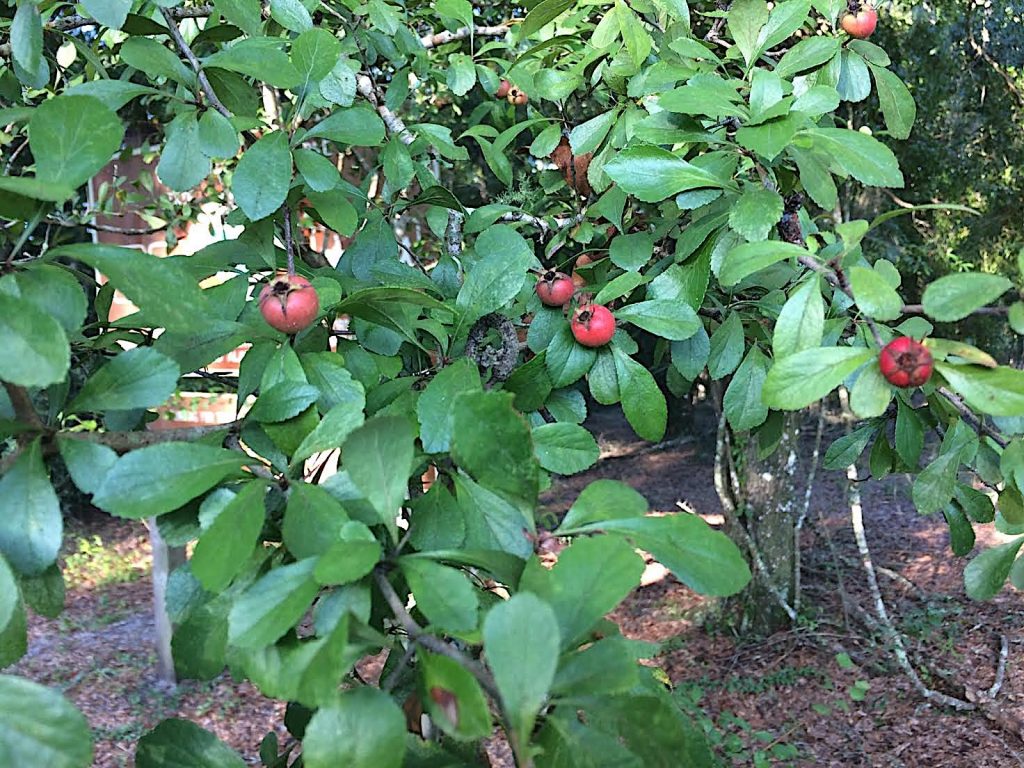
It’s common yet uncommon, that is, not rare but you don’t notice it too often. Hawthorn is a small tree that hides well in plain sight. This past weekend they were fruiting in Gainesville (and in Ocala with pink chanterelle mushrooms around them.)
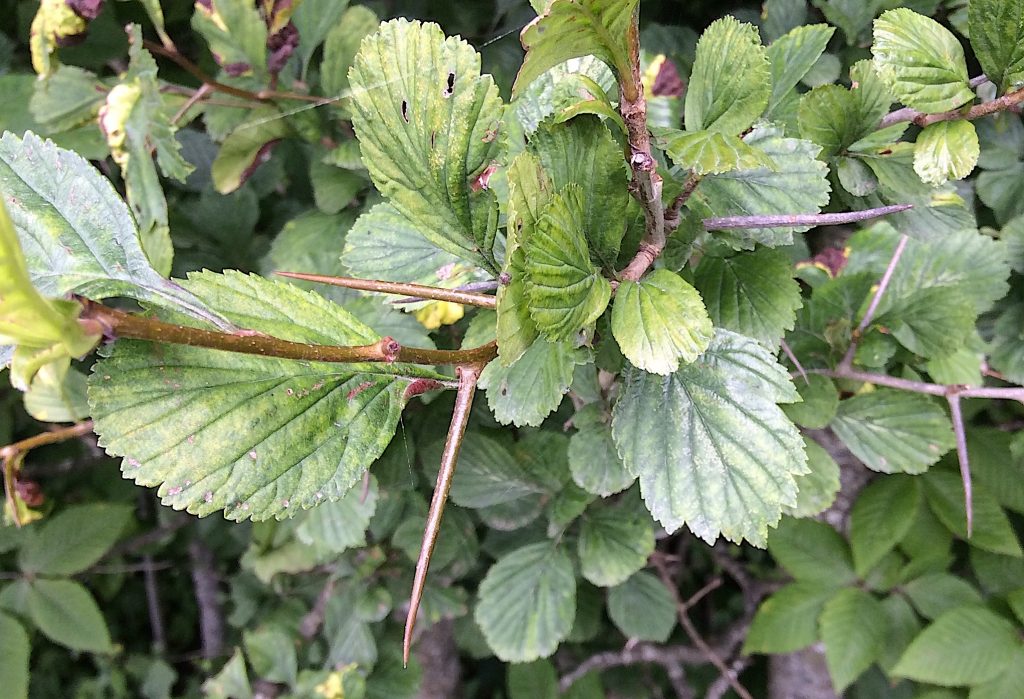
In rural Maine where I grew up there was a large Hawthorn tree across the street, which was really a country dirt road. The tree was very-well armed with thousands of huge thorns. I noticed early on that many different species of birds nested in the tree. This was probably because few predators could climb up to bother them. In the rose family like apples the fruit is edible but not the seeds which are easy to remove. Do not eat the seeds. You can eat the fruit and spit out the seeds, or, cook the fruit and strain the seeds out. The fruit has the texture and flavor of a mealy apple. The tree has medicinal uses as well. Its leaves are reported to be as effective a pharmaceutical-grade beta blocker. To read more about the Hawthorn go here
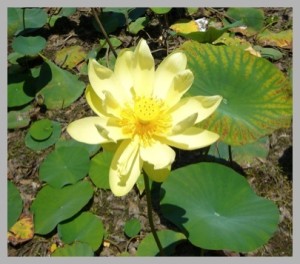
Payne’s Prairie in Gaineville, once a large lake, is now sometimes a dry lake and other times a flooded plain. Currently it is yellow with lotus blossoms. Yellow Lotus is both an easy food to forage and a difficult food to forage. If one is collecting seeds it’s very easy: Cut off the ripe tops then slice out the marble-size seeds (a curved paring knife works the best at that.) The roots are nutritious and a commercial crop however…. the key is plant density. If you have just a few plants finding the root will be near impossible as it grows deep and many feet away from the plant in any direction. The point is you really don’t know where to dig (and usually it’s also under water.) But if you have a high population density of lotus then you can dig nearly anywhere in the middle of the plants and find some roots because there are bound to be some where you dig. American Lotus seeds can stay viable for over 400 years… now there’s a survival food. To read more about the American lotus click here.

My teaching trip to Honea Path, South Carolina, was a success and we plan to do it again this October, probably the 11th, 12th and 13th. Mark your calendars. The current schedule is a class Friday around 5:30 p.m., two on Saturday, probably 9 and one, and a class on Sunday, around 2 p.m. That might change a bit between now and then and some presentations added as well. There are around seven dozen edible species at the Putney Farm where the classes are held (not counting their garden.) And as Lenard Putney is my cousin we also got a chance to talk about family and marvel that we managed to survive childhood. His wife Donna, with more organizing skills than I, is already planning the event. Be there.
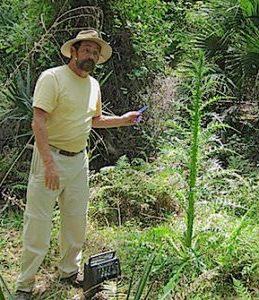
My upcoming teaching schedule has been posted out through the first week in September. Plan early and sign up for a class. Foraging classes are held rain or shine — you are hungry when it rains — though Hurricanes are an exception. This week we are visiting Wickham Park in Melbourne and Blanchard Park in Orlando.
Saturday, July 27th, Wickham Park: 2500 Parkway Drive, Melbourne, FL 32935-2335. 9 a.m. to noon. Meet at the “dog park” inside the park.
Sunday, July 28th, Blanchard Park, 10501 Jay Blanchard Trail, Orlando, FL 32817. 9 a.m. to noon. Meet next to the tennis courts by the YMCA building.
Saturday, August 3rd, Red Bug Slough Preserve, 5200 Beneva Road, Sarasota, FL, 34233. 9 a.m. to noon. Meet at the playground next to the parking lot.
Sunday, August 4th Dreher Park, 1200 Southern Blvd., West Palm Beach, 33405. 9 a.m to noon. Meet just north of the science center in the north section of the park.
Saturday, August 10th, Florida State College, south campus, 11901 Beach Blvd., Jacksonville, 32246. 9 a.m. to noon. We will meet at building “D” next to the administration parking lot.
Sunday, August 11th, Colby-Alderman Park: 1099 Massachusetts Street, Cassadaga. Fla. 32706. 9 a.m. to noon. Meet by the bathrooms.
Saturday August 17th, Eagle Park Lake, 1800 Keene Road, Largo, FL 33771. 9 a.m. to noon. Meet at the pavilion near the dog park.
Sunday August 18th, Ft. Meade Outdoor Recreation Area, 1639 Frostproof Highway, Fort Meade, FL 33841. (Frostproof Highway is also Route 98.) 9 a.m to noon. Meet at the bathrooms in the middle of the park which is due south from the highway and not near the entrance.
Saturday, August 24th, Bayshore Live Oak Park, Bayshore Drive. Port Charlotte. 9 a.m. to noon. Meet at the parking lot at the intersection of Bayshore Road and Ganyard Street. 9 a.m. to noon.
Sunday, August 25th, Blanchard Park, 10501 Jay Blanchard Trail, Orlando, FL 32817. 9 a.m. to noon. Meet next to the tennis courts by the YMCA building.
Saturday August 31st, Wekiva State Park, 1800 Wekiwa Circle, Apopka, Florida 32712. 9 a.m. to noon. Arrive very early as there will be a lot of people wanting to go to the springs at 8 a.m. to swim. There is a park admission Fee: $6 per vehicle. Limit 8 people per vehicle, $4 for a single occupant vehicle, $2 pedestrians or bicyclists. Meet at the Sand Lake parking lot (road on left after entrance. Go to end of road.) Unlike city parks or the urban area, Wekiva Park is “wild” Florida. There are very few weeds of urbanization. The edibles are mostly native plants and far between. There is a lot of walking in this class and it will also probably be hot. After class you can swim in the spring.
Sunday September 1st, George LeStrange Preserve, 4911 Ralls Road, Fort Pierce, FL, 34981. 9 a.m. to noon. The preserve has no official bathroom or drinking water so take advantage of the various eateries and gas stations before arrival.
Saturday September 7th, 329 N. Park Avenue, Winter Park. 9 a.m. to noon. Parking is free in the parking garage behind Panera’s. This is a class specializing in finding wild edibles in an urban setting. We wander through the park, around the college, to the library and back to Panera’s with a coffee pause in the middle.
Sunday September 8th, Ft. Desoto Park, 3500 Pinellas Bayway S. St. Petersburg Fl 33715. Meet by the bathrooms at the parking lot of the “bay” fishing pier (not the “gulf” fishing pier.) 9 a.m. to noon. There is a fee to get into the park. The fishing pier is about halfway along the SW/NE road along the southern end of the park.
To read more about the classes, to sign up for them or pay for a class go here.
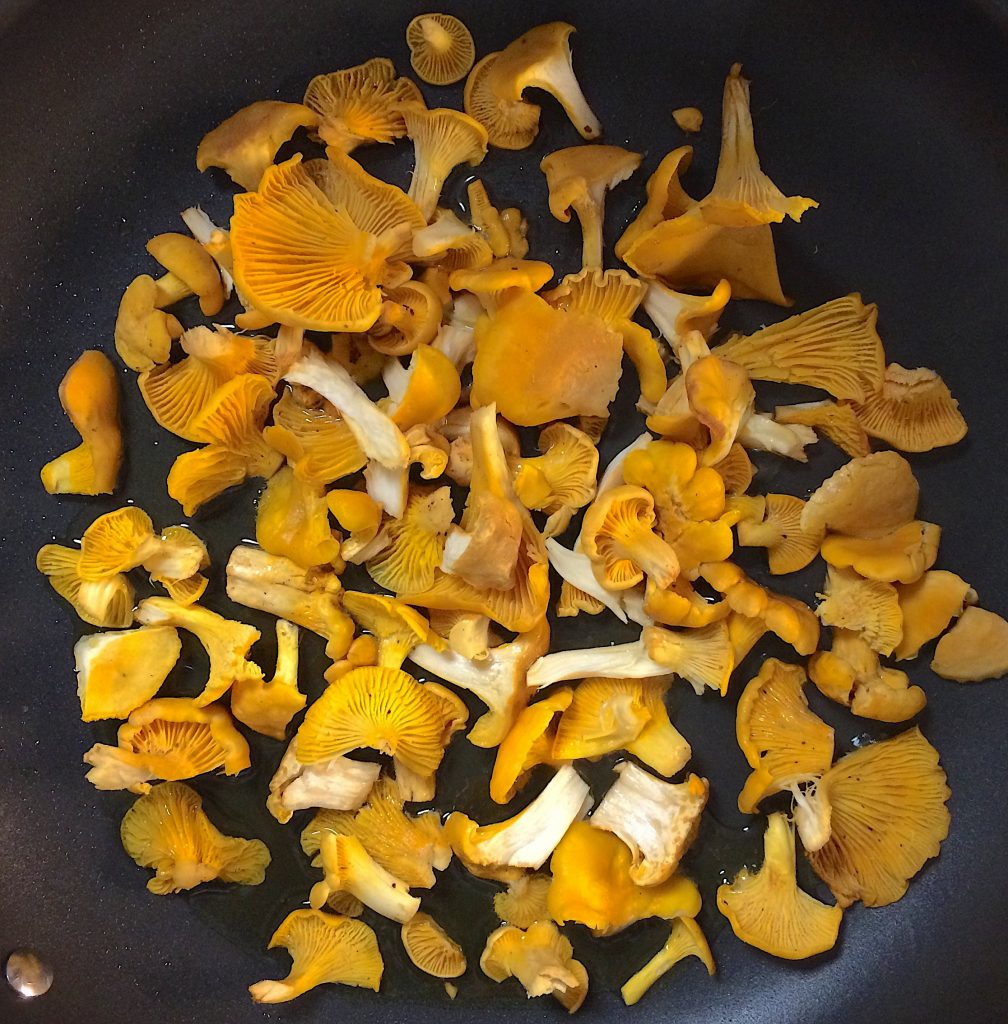
Perhaps this is the yes-and-no newsletter with three species that are easy in some ways and difficult in others. Chanterelle mushrooms fit that category especially here in Florida. One problem is the genus had not been reworked or described well. The names are in flux and perhaps the various species have not been well- examined by qualified experts. Within a few hundred feet here in central Florida I can find two very different species of chanterelles, one that funnels and grows in bunches, one that grows by itself and curls over forming a pseudo-cap. Saturday in Ocala I saw yet a third species, lighter in color, large and flaring but not in groups. As with other wild edibles I tell my students it’s usually not the name that’s important. What is important is that you recognize the species regardless of the botanical or common name (and many mushrooms do not have common names.) There are several telling characteristics of chanterelles that help separate them from other mushroom (besides having false gills.)
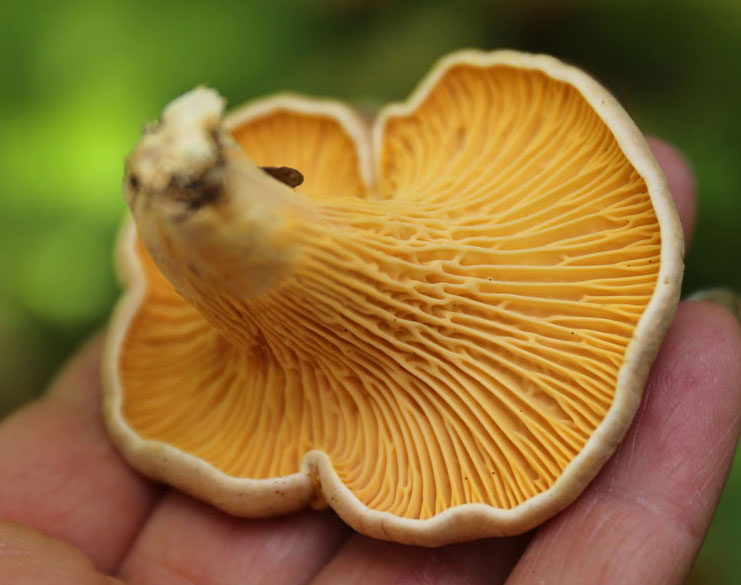
False gills can be a difficult concept to grasp. True gills are separate structures attached to the cap. They are like knife blades. False gills, in this case, are like wrinkles, as if you took cloth on a table and and bunched it together into wrinkles, less organized (like my ironing.) More often that not those wrinkles also have little connections between them that are at 90 degree forming little cross bridges, see picture above left. Chanterelles are also a different color inside than outside and in texture resemble string cheese particularly the stem. They grow on the ground — as opposed to some form of obvious wood — and are found among oaks and pines. In the same environment look for one of the edible Milk Caps, Lactifluus hygrophoroides. You can read about chanterelles in one of my newsletters here, the Milk Cap here.
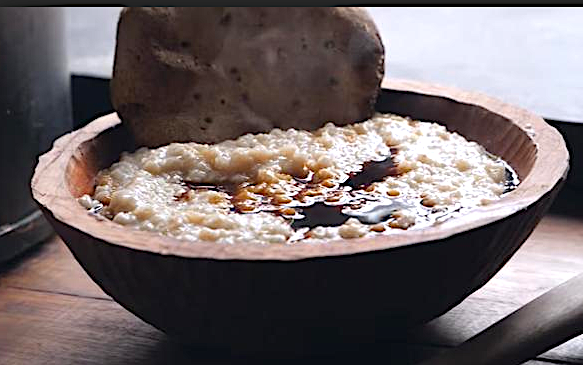
The study of plants is also the study of language and not just Dead Latin and Living Greek. Native language names often give a hint as to how the plant was used. Sometimes a word can mean several things. Burgoo is a good example. The original Burgoo was a cooked ground oatmeal which in time also came to mean any kind of thick stew. But the origin was from the sailing days when oatmeal, rolled or ground, was cooked bubbling in a vat aboard ship. Before that mess was called Burgoo it was called Loblolly which goes back over 400 years. For a long time Loblolly and Burgoo were used at the same time to mean the same thing. So why is the pine, Pinus taeda, called Loblolly? Association … in the mind of settlers. Loblolly is a combination of “Lob” meaning to eat loudly and or a thick, heavy porridge that bubbles: Think Burgoo. “Lolly” is an old British word for soup or broth. In colonial America mud holes and mires were called “Loblollies” as thy resembled the gurgling gruel (if you’ve lived though a spring mud season up north you know exactly what they mean.) The pine got its name because it grew in lowlands or about swamps. They also like to grow in clay. And if not for the whims of time and use Pinus taeda could have just as easily been called Burgoo instead of Loblolly.

Donations to upgrade EatTheWeeds.com and fund a book are going well. Thank you to all who have contributed to either via the Go Fund Me link, the PayPal donation link or by writing to Green Deane POB 941793 Maitland FL, 32794. Recent upgrades have been paid now the Forum needs work and several function
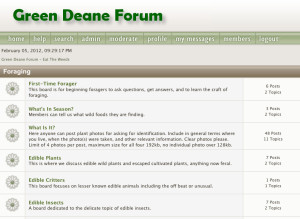
Want to identify a plant? Looking for a foraging reference? Do you have a UFO, an Unidentified Flowering Object you want identified? On the Green Deane Forum we chat about foraging all year. And it’s not just about warm-weather plants or just North American flora. Many nations around the world share common weeds so there’s a lot to talk about. There’s also more than weeds. The reference section has information for foraging around the world. There are also articles on food preservation, and forgotten skills from making bows to fermenting food. One special section is “From the Frightening Mail Bag” where we learn from people who eat first then ask questions later. You can join the forum by clicking on “forum” in the menu.

All My Videos are available for free on You Tube. They do have ads on them so every time you watch a Green Deane video I get a quarter of one cent. Four views, one cent. Not exactly a large money-maker but it helps pays for this newsletter. If you want to see the videos without ads and some in slightly better quality you can order the DVD set. It is nine DVDs with 15 videos on each for a total of 135 videos. Many people want their own copy of the videos or they have a slow service and its easier to order then to watch them on-line. The DVDs make a good gift for that forager you know especially as spring is … springing. Individual DVDs can also be ordered or you can pick and choose. You can order them by clicking on the button on the top right hand side of this page (if your window is open wide enough.) Or you can go here.
This is weekly issue #365.

